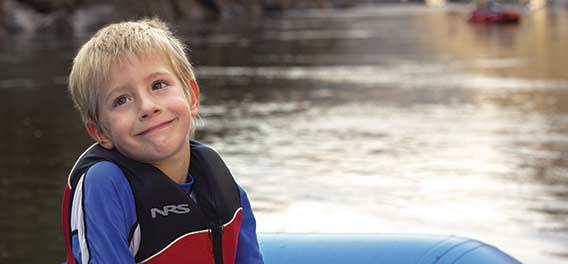Life Jacket Fiction and Fact
The life jacket, life vest, life preserver, Personal Flotation Device (PFD), buoyancy aid… whatever you choose to call it, is the first line of defense in every boater’s safety arsenal. Unfortunately, there are a number of misunderstandings, misconceptions and myths about these important safety tools.
Also, the way the US Coast Guard and Canadian regulatory agencies are now categorizing and labeling life jackets is changing. These changes differ in significant ways from the older system. If you have questions, please contact us.

Fiction: “I’m a big person, weighing 250 pounds, so I must need the largest size of that jacket.”
Fact: This is one of the more common misunderstandings we see about life jackets. It requires some detailed explanation, so bear with me.
- In the Specs tab on each life jacket product page, we list the “design flotation.” This is the pounds of flotation, or buoyancy, that the manufacturer is shooting for.
- When only one design flotation number is listed, all sizes of that jacket have the same amount of flotation.
- When there is only one design flotation listed, the only difference in the sizes is the length of the adjustment straps.
- The U.S. Coast Guard sets the standards for all USCG-approved lifejackets. For the Type III, the most common recreational type, the minimum flotation is 15.5 pounds.
- Under the New Coast Guard Approval System, the Performance Level 70 is equivalent to older system Type III.
- The Coast Guard has determined that most adults need an additional 7–12 pounds of flotation to keep their heads above water. Muscle tissue is less buoyant than fatty tissue. If you’re an ultra-fit athlete with a low body mass index (BMI) you may need all that additional flotation. If you’re like most of us, carrying an extra pound or two, you’re probably more toward the seven pounds of the flotation spectrum.
- Adult life jackets are sized by chest circumference. Check the jacket’s label or our website to see if there’s also a body weight limit.
Fiction: “Kids grow so fast, it’s best to buy a life jacket they can ‘grow into.’”
Fact: A poorly fitted life jacket is very dangerous. If it’s not a snug fit the child can slip out of it, or the jacket can ride up, so their head isn’t above water.
- Check for a proper fit by first cinching up the adjustment straps. Start by cinching the bottom strap below the ribcage.
- Now, lift up on the shoulder straps. If the jacket stays in place, it’s a good fit. If it rides up so that the front of the jacket comes up to the chin, or higher, it’s a dangerous fit.
- Try retightening the straps and repeat the lifting test. If it still rides up you’ve got the wrong jacket, or the wrong size.
- Youth-size life jackets are designed to fit young people 50–90 pounds and Child-size jackets to fit little ones 30–50 pounds. Kids dimensions vary greatly, so these weight ranges are really guidelines. The important thing is to choose a life jacket that fits your young person properly.
- If you just can’t find a jacket that doesn’t ride up, you can try leg straps. Some jackets come with leg straps. On jackets that don’t come with them you can usually secure them to the lower side adjustment straps.
- To keep your child in a good-fitting, safe life jacket as they grow, you will probably have to buy them 2–4 different jackets. That is very cheap insurance; don’t skimp on their safety.
- And please have them wear their properly adjusted jacket whenever they’re on the water; and while they’re young, even when playing near the water.

Fiction: “Life jackets are uncomfortable.”
Fact: Some life jackets are uncomfortable on some people. The shape and dimensions of the human body vary in many wondrous ways. Not every life jacket is comfortable for every boater. NRS carries over 30 different models, and there are dozens more in the marketplace. There’s one, or more, comfortable enough for all-day wear, for every boater.
Fiction: “A Type III jacket is only good for Class III rapids, and tamer.”
Fact: The USCG-type designation has nothing to do with rapid or river class ratings. The Coast Guard uses their Type I–V system to divide models into categories for the purposes of regulating features and testing. See the article ABCs of PFDs for a description of the different type designations.
Fiction: “You can’t call a PFD a “life jacket” unless it is designed to float an unconscious person face up.”
Fact: Jacket models designed to turn a person face up are generally too bulky to be comfortable for paddlesports. We use the term “life jacket” because it contains the word “life” and we hope that reinforces in boaters’ minds that these are life-saving devices.
Words have power. Personal Flotation Device (PFD) is a bland bureaucratic term. It’s kind of like “collateralized debt obligations,” the instruments that helped spark the 2008 financial crisis. If they’d been called, as Warren Buffet suggested, “financial instruments of mass destruction,” perhaps people would have paid more attention to them.
Fact: Folks here at NRS care about your safety. We promote safe boating and do our best to provide high quality safety gear. We do this not just because we want to keep you as a customer, but because you’re a fellow boater and it’s painful every time we read of a preventable loss of life. Boating has inherent dangers; don’t make it more dangerous by ignoring basic safety rules, like wearing your life jacket when you’re on the water.
Please get a good fitting life jacket and wear it. We want to see you on the water and at the takeout.
Boat Often and Boat Safe!
 NRS Gift Card: Always Fits, Always Wanted
NRS Gift Card: Always Fits, Always Wanted




